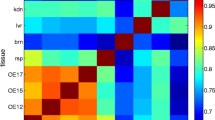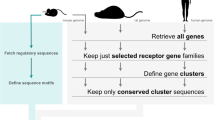Abstract
Although both genomic sequencing and expression analysis are becoming indispensable for biological research, methods that can effectively survey large public gene expression repositories remain to be established. In this study, we developed an approach for the retrieval of tissue-specific expression information for certain genes from public databases; our approach was based on performance of a basic local alignment search tool search against probes on DNA microarray chips. To test the effectiveness of this approach, we examined the expression of human odorant receptors in non-olfactory tissues, as recent studies showed that such non-olfactory odorant receptors have physiological and pathophysiological significance. When we screened a large expression data set using this approach, we were able to effectively identify candidate odorant receptors in non-olfactory tissues and confirmed their expression by reverse transcription-polymerase chain reaction. Using receiver-operating characteristic curve analysis, the sensitivity and the specificity of this approach were 60 and 68%, respectively, indicating that the use of this technique would efficiently identify the previously unidentified expression of odorant receptors in non-olfactory tissues. Taken together, the in silico approach, as shown in the present study, would facilitate to elucidate the function of genes of interest.




Similar content being viewed by others
References
Barrett T, Suzek TO, Troup DB, Wilhite SE, Ngau WC, Ledoux P, Rudnev D, Lash AE, Fujibuchi W, Edgar R (2005) NCBI GEO: mining millions of expression profiles-database and tools. Nucleic Acids Res 33(Database issue):D562–D566
Buck L, Axel R (1991) A novel multigene family may encode odorant receptors: a molecular basis for odor recognition. Cell 65(1):175–187
Dias Neto E, Correa RG, Verjovski-Almeida S, Briones MR, Nagai MA, da Silva W, Jr., Zago MA, Bordin S, Costa FF, Goldman GH, Carvalho AF, Matsukuma A, Baia GS, Simpson DH, Brunstein A, de Oliveira PS, Bucher P, Jongeneel CV, O’Hare MJ, Soares F, Brentani RR, Reis LF, de Souza SJ, Simpson AJ (2000) Shotgun sequencing of the human transcriptome with ORF expressed sequence tags. Proc Natl Acad Sci USA 97(7):3491–3496
Feldmesser E, Olender T, Khen M, Yanai I, Ophir R, Lancet D (2006) Widespread ectopic expression of olfactory receptor genes. BMC Genomics 7:121
Gaudin JC, Breuils L, Haertle T (2001) New GPCRs from a human lingual cDNA library. Chem Senses 26(9):1157–1166
Glusman G, Yanai I, Rubin I, Lancet D (2001) The complete human olfactory subgenome. Genome Res 11(5):685–702
Lipshutz RJ, Morris D, Chee M, Hubbell E, Kozal MJ, Shah N, Shen N, Yang R, Fodor SP (1995) Using oligonucleotide probe arrays to access genetic diversity. Biotechniques 19(3):442–447
Metz CE (1978) Basic principles of ROC analysis. Semin Nucl Med 8(4):283–298
Mombaerts P (1999) Molecular biology of odorant receptors in vertebrates. Annu Rev Neurosci 22:487–509
Olender T, Feldmesser E, Atarot T, Eisenstein M, Lancet D (2004a) The olfactory receptor universe—from whole genome analysis to structure and evolution. Genet Mol Res 3(4):545–553
Olender T, Fuchs T, Linhart C, Shamir R, Adams M, Kalush F, Khen M, Lancet D (2004b) The canine olfactory subgenome. Genomics 83(3):361–372
Parkinson H, Kapushesky M, Shojatalab M, Abeygunawardena N, Coulson R, Farne A, Holloway E, Kolesnykov N, Lilja P, Lukk M, Mani R, Rayner T, Sharma A, William E, Sarkans U, Brazma A (2007) ArrayExpress—a public database of microarray experiments and gene expression profiles. Nucleic Acids Res 35(Database issue):D747–D750
Parmentier M, Libert F, Schurmans S, Schiffmann S, Lefort A, Eggerickx D, Ledent C, Mollereau C, Gerard C, Perret J et al. (1992) Expression of members of the putative olfactory receptor gene family in mammalian germ cells. Nature 355(6359): 453–455
Pruitt KD, Tatusova T, Maglott DR (2005) NCBI Reference Sequence (RefSeq): a curated non-redundant sequence database of genomes, transcripts and proteins. Nucleic Acids Res 33(Database issue): D501–D504
Rozen S, Skaletsky H (2000) Primer3 on the WWW for general users and for biologist programmers. Methods Mol Biol 132:365–386
Schena M, Shalon D, Davis RW, Brown PO (1995) Quantitative monitoring of gene expression patterns with a complementary DNA microarray. Science 270(5235):467–470
Spehr M, Gisselmann G, Poplawski A, Riffell JA, Wetzel CH, Zimmer RK, Hatt H (2003) Identification of a testicular odorant receptor mediating human sperm chemotaxis. Science 299(5615):2054–2058
Spehr M, Schwane K, Riffell JA, Barbour J, Zimmer RK, Neuhaus EM, Hatt H (2004) Particulate adenylate cyclase plays a key role in human sperm olfactory receptor-mediated chemotaxis. J Biol Chem 279(38):40194–40203
Su AI, Wiltshire T, Batalov S, Lapp H, Ching KA, Block D, Zhang J, Soden R, Hayakawa M, Kreiman G, Cooke MP, Walker JR, Hogenesch JB (2004) A gene atlas of the mouse and human protein-encoding transcriptomes. Proc Natl Acad Sci USA 101(16):6062–6067
Vanderhaeghen P, Schurmans S, Vassart G, Parmentier M (1997) Specific repertoire of olfactory receptor genes in the male germ cells of several mammalian species. Genomics 39(3):239–246
Weigle B, Fuessel S, Ebner R, Temme A, Schmitz M, Schwind S, Kiessling A, Rieger MA, Meye A, Bachmann M, Wirth MP, Rieber EP (2004) D-GPCR: a novel putative G protein-coupled receptor overexpressed in prostate cancer and prostate. Biochem Biophys Res Commun 322(1):239–249
Zhang X, Firestein S (2002) The olfactory receptor gene superfamily of the mouse. Nat Neurosci 5(2):124–133
Zhang X, Rogers M, Tian H, Zhang X, Zou DJ, Liu J, Ma M, Shepherd GM, Firestein SJ (2004) High-throughput microarray detection of olfactory receptor gene expression in the mouse. Proc Natl Acad Sci USA 101(39):14168–14173
Zozulya S, Echeverri F, Nguyen T (2001) The human olfactory receptor repertoire. Genome Biol 2(6):RESEARCH0018
Acknowledgments
This work was supported by a Grant-in-Aid for the 21st Century COE “Knowledge Information Infrastructure for Genome Science”, Special Coordination funds for Promoting Science and Technology from the Ministry of Education, Culture, Sports, Science and Technology (MEXT) of Japan.
Author information
Authors and Affiliations
Corresponding author
Rights and permissions
About this article
Cite this article
Ichimura, A., Kadowaki, T., Narukawa, K. et al. In silico approach to identify the expression of the undiscovered molecules from microarray public database: identification of odorant receptors expressed in non-olfactory tissues. Naunyn-Schmied Arch Pharmacol 377, 159–165 (2008). https://doi.org/10.1007/s00210-007-0255-6
Received:
Accepted:
Published:
Issue Date:
DOI: https://doi.org/10.1007/s00210-007-0255-6




